Uncategorized
UNAIDS releases 2017 Global AIDS Update report

Press release
The scales have tipped—UNAIDS announces 19.5 million people on life-saving treatment and AIDS-related deaths halved since 2005
The 90–90–90 targets are galvanizing global action and saving lives. Eastern and southern Africa leading the way in reducing new HIV infections by nearly 30% since 2010—Malawi, Mozambique, Uganda and Zimbabwe have reduced new HIV infection by nearly 40% or more since 2010. Concerted efforts still needed for children, adolescents, men and key populations, and in certain regions.
GENEVA/PARIS, 20 July 2017—UNAIDS has released a new report showing that for the first time the scales have tipped: more than half of all people living with HIV (53%) now have access to HIV treatment and AIDS-related deaths have almost halved since 2005. In 2016, 19.5 million of the 36.7 million people living with HIV had access to treatment, and AIDS-related deaths have fallen from 1.9 million in 2005 to 1 million in 2016. Provided that scale-up continues, this progress puts the world on track to reach the global target of 30 million people on treatment by 2020.
“We met the 2015 target of 15 million people on treatment and we are on track to double that number to 30 million and meet the 2020 target,” said Michel Sidibé, Executive Director of UNAIDS. “We will continue to scale up to reach everyone in need and honour our commitment of leaving no one behind.”
The region showing the most progress is eastern and southern Africa, which has been most affected by HIV and which accounts for more than half of all people living with HIV. Since 2010, AIDS-related deaths have declined by 42%. New HIV infections have declined by 29%, including a 56% drop in new HIV infections among children over the same period, a remarkable achievement resulting from HIV treatment and prevention efforts that is putting eastern and southern Africa on track towards ending its AIDS epidemic.
To read more and access the full report visit: http://www.unaids.org/en/resources/campaigns/globalAIDSupdate2017
PEPFAR update
Press Releases: Update on the President’s Emergency Plan for AIDS Relief (PEPFAR)
07/24/2017 08:07 AM EDT
Media Note
Office of the Spokesperson
Washington, DC
July 24, 2017
 Today, the United States announced that through support from the U.S. President’s Emergency Plan for AIDS Relief (PEPFAR) four African countries are approaching control of their HIV epidemics.
Today, the United States announced that through support from the U.S. President’s Emergency Plan for AIDS Relief (PEPFAR) four African countries are approaching control of their HIV epidemics.
Groundbreaking new PEPFAR data show that the HIV epidemic is coming under control across all age groups in Swaziland, the country with the highest HIV prevalence in the world. Additional PEPFAR-supported studies released in December 2016 for Malawi, Zambia, and Zimbabwe also demonstrate significant progress toward controlling the HIV epidemics in these countries.
In Swaziland, new HIV infections have been nearly halved among adults, and HIV viral load suppression – a key marker of the body successfully controlling the virus – has doubled since 2011. These data suggest that Swaziland has met the global target for community viral load suppression among HIV-positive adults four years ahead of schedule. The Swaziland data is particularly important because PEPFAR funded a comprehensive survey in 2011-2012, which provides the critical baseline comparator of current results and progress.
Today’s findings demonstrate the remarkable impact of the U.S. government’s efforts, through PEPFAR and the Global Fund to Fight AIDS, Tuberculosis and Malaria, in close collaboration with African countries and other partners.
The United States is the largest bilateral donor to the global HIV/AIDS response. Through PEPFAR, the United States continues to invest in over 50 countries, ensuring access to services by all populations, including the most vulnerable and at-risk groups. Malawi, Swaziland, Zambia, and Zimbabwe are among the 13 highest-burden countries that have the greatest potential to control their epidemics by 2020 through the UNAIDS 90-90-90 framework and expansion of HIV prevention, leading PEPFAR to accelerate its efforts in these particular countries.
For more information about PEPFAR, visit: www.pepfar.gov
Support us when you shop on Prime Day
Amazon’s third-annual Prime Day is on Tuesday, July 11 and will feature more than 100,000 deals exclusively for Prime members, making it one of the biggest shopping days of the year. When you #StartWithaSmile on #PrimeDay, Amazon donates to Children’s AIDS Fund. Shop for great deals at smile.amazon.com/ch/54-1436973
National HIV Testing Day — June 27, 201
 Today is National HIV Testing Day. Join us in raising awareness as we highlight the importance of testing in detecting, treating, and preventing human immunodeficiency virus (HIV) infection. This year the federal theme is “Test Your Way, Do it Today”. For additional information visit https://www.hiv.gov/
Today is National HIV Testing Day. Join us in raising awareness as we highlight the importance of testing in detecting, treating, and preventing human immunodeficiency virus (HIV) infection. This year the federal theme is “Test Your Way, Do it Today”. For additional information visit https://www.hiv.gov/
Celebrating Mothers Everywhere
 Once every year the world over we celebrate mothers. No matter the country, the culture, the economic status, mothers are the universal nurturers that impact every aspect of their children’s lives. Despite existing challenges or available resources, every mother’s daily priority is their children’s well-being.
Once every year the world over we celebrate mothers. No matter the country, the culture, the economic status, mothers are the universal nurturers that impact every aspect of their children’s lives. Despite existing challenges or available resources, every mother’s daily priority is their children’s well-being.
HIV-positive mothers are no exception. Many single-handedly raise their children, often without help from family members, friends or community. They struggle to provide for their children–some who may be HIV positive–all the while trying to make ends meet. At the same time like all other mothers, they attempt to create joy for their kids and shield them from life’s difficulties. Many find creative ways to raise funds for survival. They make paper beads, raise livestock and poultry, grow crops to sell on the side of the road. In essence they become entrepreneurs and small business owners to clothe and feed their children.
Together let’s honor them, pray for them, learn from them, and commit to ongoing support and encouragement for them.
These remarkable women are role models for us all. Facing the challenges of their own HIV disease, and too often shunned by their families and communities, they constantly strive to provide stability, health and hope for their children.
Your support has provided small seed loans for so many women to begin entrepreneurial activities to feed and support their children. In addition, your commitment to helping HIV-impacted children and families has opened the doors to educational scholarships, counseling and clinical interventions.
We join you in celebrating HIV-positive mothers. Together let’s honor them, pray for them, learn from them, and commit to ongoing support and encouragement for them.
World Immunization Week 2017 – April 24 – 30, 2017
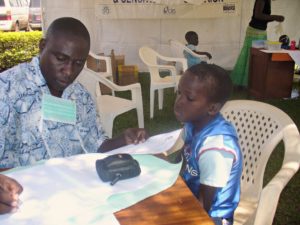 In May 2012, 194 Member States of the World Health Assembly endorsed a plan they hoped would help prevent millions of deaths from vaccine-preventable diseases through universal access to immunizations. This event marked the beginning of the Global Vaccine Action Plan (GVAP). GVAP is designed to prevent millions of deaths by 2020 through more equitable access to existing vaccines for people in all communities around the globe. 2017 marks the halfway point of this plan.
In May 2012, 194 Member States of the World Health Assembly endorsed a plan they hoped would help prevent millions of deaths from vaccine-preventable diseases through universal access to immunizations. This event marked the beginning of the Global Vaccine Action Plan (GVAP). GVAP is designed to prevent millions of deaths by 2020 through more equitable access to existing vaccines for people in all communities around the globe. 2017 marks the halfway point of this plan.
World Immunization Week – commemorated the last week of April – aims to promote the use of vaccines to protect people of all ages against disease. Immunization saves millions of lives and is widely recognized as one of the world’s most successful and cost-effective health interventions. Despite this focused effort, today there are still 19.4 million unvaccinated and under-vaccinated children in the world.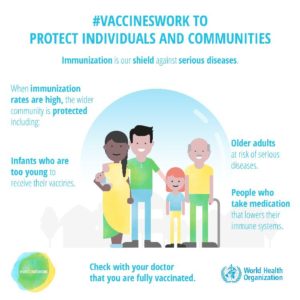
The campaign’s main goal is raising awareness about the about the critical importance of full immunization by the World Health Organization (WHO). But despite improvements in many countries and a strong global rate of new vaccines introduction, vaccinations for all diseases targeted for elimination are behind schedule. This year the WHO and its partners aim is to inform the public on three major points:
Highlight the importance of immunization as a top global health investment priority.
Promote understanding of the action steps required to achieve the Global Vaccine Action Plan.
Showcase immunization’s role in sustainable development and global health security.
Celebrating World Malaria Day
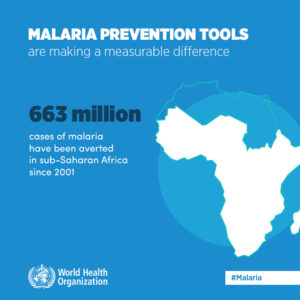 Today we celebrate the amazing results of the last 16 year fight against malaria. World Malaria Day commemorates the date in 2000, when 44 African leaders met in Nigeria and committed their countries to reducing malaria-related deaths.
Today we celebrate the amazing results of the last 16 year fight against malaria. World Malaria Day commemorates the date in 2000, when 44 African leaders met in Nigeria and committed their countries to reducing malaria-related deaths.
Malaria is a life-threatening disease caused by parasites that are transmitted to people through the bites of infected female Anopheles mosquitoes. In 2015, 91 countries had ongoing malaria transmission. Malaria is preventable and curable, and increased efforts are dramatically reducing the malaria burden in many places
Let’s Close the Gap
Between 2010 and 2015, malaria incidence among populations at risk (the rate of new cases) fell by 21% globally. In that same period, malaria mortality rates among populations at risk fell by 29% globally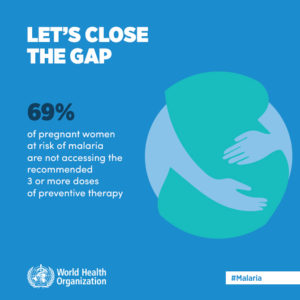 among all age groups, and by 35% among children under 5. Sub-Saharan Africa carries a disproportionately high share of the global malaria burden. In 2015, the region was home to 90% of malaria cases and 92% of malaria deaths
among all age groups, and by 35% among children under 5. Sub-Saharan Africa carries a disproportionately high share of the global malaria burden. In 2015, the region was home to 90% of malaria cases and 92% of malaria deaths
In addition to the 44 African leaders who pledged to take this path in 2000, Asian leaders have joined the fight. Dozens of global partners have contributed funds, staff, supplies, and expertise to enable us to achieve these amazing results: the Bill and Melinda Gates Foundation, the US government, the UK government, millions of individuals who have donated to the many non-governmental agencies working to end malaria.
Love is more than chocolates and flowers
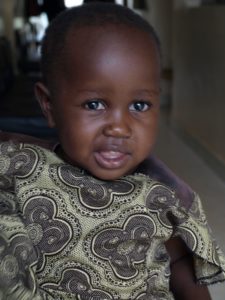 Love. Caring. Affection. These are the cornerstones of relationships and what we celebrate on Valentine’s Day. In the U.S. we give dinners out, cards, chocolate and flowers to show those we love how much we care. Thousands of HIV impacted children never feel love, caring or affection, much less on Valentine’s Day.
Love. Caring. Affection. These are the cornerstones of relationships and what we celebrate on Valentine’s Day. In the U.S. we give dinners out, cards, chocolate and flowers to show those we love how much we care. Thousands of HIV impacted children never feel love, caring or affection, much less on Valentine’s Day.
Your gift to CAFI this Valentine’s Day will provide nutritious food, school fees, clothing or other essentials of life and will let HIV impacted children know that someone actually does remember them and care.
Your gift this Valentine’s Day will let HIV impacted children know that someone actually does remember them and care.
$75 provides counseling and clinical intervention to prevent HIV transmission from pregnant mother to child. $60 buys eight hours of life skills, HIV, STI and universal values education to help keep youth HIV free. $50 will purchase two chickens. Poultry can supply fresh eggs that provide essential nutrition for a family’s health, as well as income from extra eggs to purchase essentials like shoes and clothes.
Any amount you give this Valentine’s Day will be used by CAFI to provide love, caring and affection to these precious and too often-forgotten HIV impacted children.
Thank you so much for your part in this life-saving work!
Putting Life’s Challenges in Perspective
Every now and then when life’s issues seem to be overwhelming it is important to put things into perspective. One young man helps me do that. His name is Junior.
By age 5 Junior had lost his father and by age 13, his mother had also died from AIDS and he was very sick himself. He became the first patient at a Children’s AIDS Fund International supported HIV clinic in Kampala, Uganda. I met him when he handed me flowers during the clinic’s opening ceremony.
Once diagnosed, Junior responded well to HIV treatment. Because Junior was without an adult guardian, a concerned American who met him and learned his story put a substantial amount of money in the bank to help with Junior’s care and needs. In less than a year the money was gone and Junior was left alone and destitute by the greedy relatives who had used it for themselves.
Despite this very personal hurt and disappointment Junior continued in school, studied hard and looked forward to attending the largest local university. Through the generosity of donors who knew Junior’s story he was able to enroll and decided to major in social work.
Just into his second year, at age 19, Junior’s health became extremely fragile. He was diagnosed with kidney failure, had to begin dialysis and drop his studies. That was three years ago. Today, Junior is still on dialysis twice a week, hoping that one day there will be money for a transplant that might give him a better life. He works as he is physically able to contribute to his treatment.
Describing his circumstances, Junior wrote: Sometimes I sit down, not under a tree or shade but anywhere and think to myself. Looking back at the things I have gone through, first my parents dying when I was young, then having HIV and now kidney failure. All I can say is that life has not been fair to me in very many ways. But still at the end of the day I kneel down and say: “Thank you God for the gift of life you have given me.”
Next time life is overwhelming, think about Junior and the millions of other children orphaned by HIV around the world. And be thankful.
US HIV Epidemic a Continuing Reality
 While much of the media attention and funding focuses in the global pandemic—particularly on hardest hit sub-Saharan Africa–reality is that the US HIV epidemic is an ongoing reality.
While much of the media attention and funding focuses in the global pandemic—particularly on hardest hit sub-Saharan Africa–reality is that the US HIV epidemic is an ongoing reality.
According to the US Centers for Disease Control and Prevention (CDC), more than 1.1 million people in the US age 13 and older are living with HIV infection and almost 1 in 6 (15.8%) don’t know they are infected. The US has about 50,000 new HIV infections per year. Over the past decade the number of people living with HIV has increased while the annual number of new HIV infections has remained relatively stable at around 50,000.
Every 9.5 minutes someone in the US is diagnosed with HIV
HIV/AIDS is not evenly distributed across the US. Generally HIV and AIDS are concentrated in urban areas. In 2009, the number of adults and adolescents living with an HIV diagnosis was highest in the South. In 2010, blacks accounted for the largest proportion of AIDS diagnoses in the South, Northeast and Midwest.
Men who have sex with men, particularly young African American men, are most seriously affected by HIV, accounting for 78% of new infections in 2010.
Hispanics/Latinos represent 16% of the population but accounted for 21% of new HIV infections in 2010. In 2010 the rate of new HIV infections for Latino males was 2.9 times that for white males and the rate of infections for Latinas was 4.2 times that for white females.
African Americans continue to experience the most severe burden of HIV compared with other races and ethnicities, representing about 12% of the US population but accounting for 44% of new HIV infections in 2010. Unless the course of the epidemic changes, at some point in their lifetime an estimated 1 in 16 black men and 1 in 32 black women will be diagnosed with HIV infection.
Note: Statistics taken from www.aids.gov.


